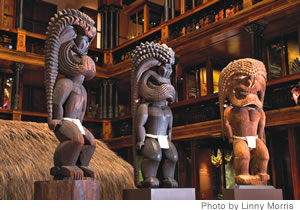That was my manaʻo for today, for this whole first week of school basically. For the first time, since its re-opening, I went to Hawaiʻi Hall at the Bishop Museum to help hoʻoulu a kupu i kuʻu naʻau.
(Photo: Honolulu Midweek/July 14, 2010/E Kū Ana Ka Paia, Bishop Museum-Hawaiʻi Hall/The unification of these three Kū back in Hawaiʻi after leaving approximiately over 150 years ago.
Hawaiʻi Hall is beautiful, I am really happy with the new renovations and restorations. I am also very glad that all the exhibits were switched out and it now can be truly called "Hawaiʻi Hall". All of the exhibits showcased artifacts from our people and our history. I also got a re-awakening of who I am and why I am doing what I do.
I first walked in, with pale on the right wrist, did my little pule for myself and the kūpuna to hear. I asked for protection, but I also asked to gain knowledge. And there they were, Kū, the kiʻi carvings that once stood proudly at their respective heiau for our people to hoʻomana. They are from a time period that is foreign to Hawaiians today, I am sad to say that the Kū had a very long return trip home only to come to a different Hawaiʻi. But I honestly feel that they will help us further remember who we are and what we need to do.
At 1:00 p.m., I sat in on a "Ola Nā Moʻolelo" session, this one in particular about the events leading up to the overthrow and what happened after, entitled "Mai Poina ʻOe Iaʻu". Lokomaikaʻi, one of the workers of Bishop Museum, played a Hawaiian woman living during the time of the Overthrow. She entered singing/chanting "Kaulana Nā Pua" with tears in her eyes. As she incorporated the events leading up to the Overthrow with her life experiences, I started crying. I admit, I cry a lot during movies and stuff, but that is in the comfort of my home by myself. It is not often I will cry in front of strangers in a brightly lit setting. To hear again the fate of our people those hundred some years ago, way before even the birth of my grandparents, I had to cry; I had to let the naʻau speak for it was its way to remind me why I am Hawaiian.
Later, I made my way to the third floor of Hawaiʻi Hall and came across the silver ribbon that inspired the story I heard at 1:00. It was about a foot long, silver ribbon, with red text that read "Mai Poina ʻOe Iaʻu" and above it the signature from Queen Liliʻuokalani herself. I cried again, luckily it was in the corner of the floor and I was by myself. Firstly, I thought to myself, I wouldn't dare to forget our beloved Liliʻu and secondly, I was standing in front of something Liliʻu touched herself, her name that she wrote herself. And nearby was Queen Liliʻokalani's gown that she wore to Kalākaua's coronation. Her mana was definitely felt in that corner.
Down the corridor from the silver ribbon was something I did not know still existed. Kāʻei Kapu o Līloa, Ka Malo o Līloa, and Nalukoki (Līloa's niho palaoa) were all in a display case right in front of me. And there went the tears again. I took Lilikalā's HWST 341: Hawaiian Genealogies class and learned about Līloa, his wahine ʻAkahiakuleana and their son ʻUmi-a-Līloa and about these items. These items date back to the 1400s and I thought these items were lost or returned to the earth, but no. To have something physical in front of you that had been touched by an Aliʻi from that long ago, hundreds of years even before Kamehameha I himself is just awestruck.
Before I left, I finally made my presence in front of the Kū. But before this, I hugged friends goodbye and my pale lāʻī came lose and then came off. I was surprised, it lasted the entire 2 or 3 hours I spent in Hawaiʻi Hall, but just before I go to see Kū, it comes off. I decided to still make my way to Kū, if anything bad happened or I had a bad feeling, I would turn away, but no. I walked up to the three kiʻi and made my presence known to show respect of who I was and my intentions. In my naʻau, I felt okay. I felt confirmation that my intentions of working in Ka Papahana Kaiapuni Hawaiʻi (Hawaiian Immersion Education Program) is my kuleana now and the bigger picture is to help re-build our people to their highly esteemed status that they once held. And no, I didn't cry again. Although walking to observe Kū, the two security guards that sat away decided to sit closer to Kū. I guess because I had the red Aloha Army t-shirt and with my long, tied back hair I looked like I would do something Kūʻē. Look at the stereotyping for Hawaiians today, sheesh!
Overall, mahalo iā ʻoukou. This is a great way to start my Masters program. This is was a good welcome for me to get that much closer to really putting my mark in Hawaiian history.

No comments:
Post a Comment